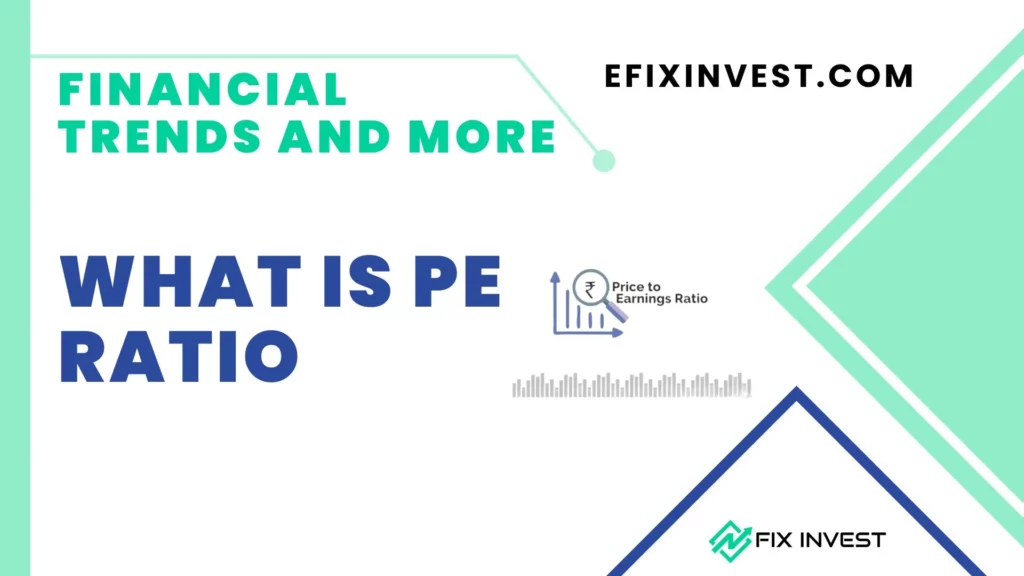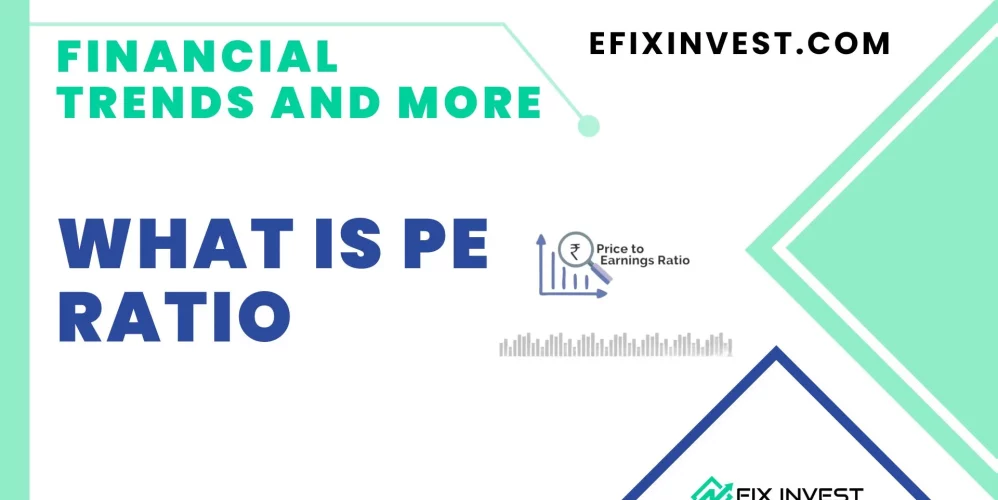What is P/E Ratio | Types of PE Ratio | Formula of PE Ratio | Advantages of PE Ratio| Limitations of PE Ratio | Good PE Ratio
You must have a good knowledge of the stock market to choose a good stock. Out of that, there is a term called PE Ratio which is very helpful to choose any good stock. Therefore, in this article, you will get to know about it in detail so that you will know another way to invest in a good stock.
The full form of P/E Ratio is Price to eEarning ratio. That is, if we compare the share price by its earning per share, then we get the P/E ratio. It is very valuable metric which is used to find out whether any share is overvalued or undervalued. But sometimes due to the valuation of the share, we cannot find out whether it is good or bad. Why so? we will know in this article.
Table of Contents
ToggleWhat is PE Ratio?
With the help of Price-To-Earning Ratio, we get to know about how much we can earn from any share. That is, with the help of this we can find out how much money will have to be invested to earn one rupee or in another word, how much money people are ready to give to the company to earn one rupee. We will understand further details from this, so stay tuned till the end of this blog. So, let’s know about the P/E Ratio in detail, Types, Formula and how you can use it in your investment.
Watch this video for better understanding –
PE Ratio Formula and Calculation
The easiest way to calculate the P/E Ratio is to divide the earnings per share (EPS) by the market share price of the company.

Market share price you will get from any screener but you will have to find the earning per share share. Basically, we can find EPS by dividing net profit of the company to its total number of shares. So in this we are knowing about PE Ratio, so without going into the depth of EPS, let us see the calculation of PE Ratio.
Suppose there is a company whose EPS is 5 and now the share price is running at 145 then the P/E ratio will be –
P/E = 145/5 = 19
How to Interpret the P/E Ratio
One of the most popular methods for investors and analysts to estimate a stock’s relative value is the price-to-earnings ratio (P/E). A stock’s P/E ratio may be used to assess whether it is overpriced or undervalued. The P/E ratio of a firm may also be compared to other companies in the same sector or to the whole market, such as the S&P 500 Index.
Occasionally, analysts who are interested in long-term valuation patterns will take into account the P/E 10 or P/E 30 metrics, which, respectively, average the last 10 or prior 30 years of earnings. Because these longer-term measurements can account for changes in the business, they are frequently used to estimate the total worth of stock indices like the S&P 500.
Also Read – Power Finance Corporation: PFC Share Price Target 2023, 2024, 2025, 2026, 2030
What is a good PE Ratio?
PE Ratio that every investors must Check before investing in any stock But the thing is people don’t know what is a good P/E Ratio and they lose money by not using it properly. As we told that if you want to earn one rupee from any share, then how much money you have to spend, it tells the P/E Ratio. Let understand it with an example –
Example – If the share price of a company is 100 and its EPS is 20, then the P/E Ratio of that company will be 5. Means you have to pay 5 rupees to earn 1 rupee I.e. you will get the return of 20%.
This does not mean that you will consider the stock with less P/E to get better returns. Let us took another example so that there is no doubt in your mind.
1st Case Example – In the first case, we will know how to identify a good stock due low P/E Ratio.
| Year | Share Price | Earning Per Share | P/E Ratio |
|---|---|---|---|
| 2020 | 100 | 20 | 5 |
| 2021 | 105 | 21 | 5 |
| 2022 | 110 | 22 | 5 |
In First Example the P/E Ratio of the company is 5 but the company’s EPS is increasing at a growth rate of 5%, which is not good at all. So in this the P/E Ratio of the company is low as well as it has an EPS growth of 5% which is considered low. This means that this is a low P/E, low growth company, in which the share price will increase very slowly because its earning is growing slowly and you will not get much profit.
| Year | Share Price | Earning Per Share | P/E Ratio |
|---|---|---|---|
| 2020 | 200 | 10 | 20 |
| 2021 | 200 | 20 | 10 |
| 2022 | 200 | 40 | 5 |
In second Example, the company’s earning per share is increasing but due to some reason its share price is not increasing. Due to which the P/E ratio of the company is decreasing. So its EPS is increasing with 100% returns but the P/E ratio is decreasing, still it can be a good investment. That is, the decrease in the P/E ratio does not mean that it is not a good investment every time, as we saw in the previous case.
2nd Case Example – In the second case, we will learn how to identify good stocks by having high P/E ratio.
| Year | Share Price | Earning Per Share | P/E Ratio |
|---|---|---|---|
| 2020 | 100 | 10 | 10 |
| 2021 | 400 | 25 | 16 |
| 2022 | 800 | 40 | 20 |
First Example – In this we can see that both the share price and earning per share of the company are increasing. But the share price is increasing very fast due to which the P/E of the company is also increasing. So in this situation, a high P/E stock may turn out to be a good investment. Generally, the share price of high growth companies tends to grow very quickly, so its P/E is also high. But this does not mean that you should start considering high P/E stocks now. So, let’s have a look on second example –
| Year | Share Price | Earning Per Share | P/E Ratio |
|---|---|---|---|
| 2020 | 280 | 20 | 14 |
| 2021 | 240 | 15 | 16 |
| 2022 | 200 | 10 | 20 |
Second Example – So in this, we can see that the share price and EPS of the company are continuously decreasing. But its earnings per share is falling faster than share price due to which its P/E Ratio is increasing.Therefore, it may also happen that it may not be a good investment even if the P/E Ratio increases.
Also Read – Buy or Sell: Vikas Lifecare Share Price Target 2023, 2024, 2025, 2026, 2030
Types of PE Ratio

Due to having 2 types of EPS, we also get to see 2 types in P/E ratio. The first is the Trailing P/E ratio and the second is the Forward P/E ratio.
- Trailing Twelve Months (TTM) P/E Ratio – This metric is the most widely used form because it is the most authentic. Basically, trailing P/E is calculated by Dividing Current share price to its previous 4 quarter Earning Per Share (EPS). It is much easier to calculate because historical data is used i.e. companies declare the financial results every quarter and it is more authentic than Forward P/E, how can it be known now?
- Forward P/E Ratio – To get the forward P/E, we need to divide the current share price by the predicted EPS. Therefore it is not very accurate as it uses estimated figures. It takes a lot of expertise to get forward P/E because in this we have to predict the growth of the company.
Advantages and Limitations of PE Ratio
It is not so easy to predict the stock market by a single metric to estimate its potential. There are many such metrics which have advantages as well as limitations. Similar is the case with P/E ratios as well, let us first look at its Advantages of PE Ratio, after that we will see its disadvantages.
- Advantages
- With the help of this we can find out which company is getting the lowest price.
- With the help of this we can find out the high growth company. PE of high growth company is very high. This happens because people show interest in buying by paying more money.
- PE ratio is also one of the important tools with the help of which we get help in analyzing the company.
- Disadvantages
- This makes it difficult to use correctly as different industries have different PE.
- It does not happen every time that the company which has low PE is getting cheap price or the one whose PE is high is high growth company and vice versa.
- Earning Per Share (EPS) is used to calculate PE ratio, which is misleading
Conclusion
We have tried our best to make you understand about Price to Earning Ratio as best as possible. Improvement will be done in this article gradually so that this blog becomes more and more informative. Maybe you can also tell your opinion about the P/E ratio in the comment section so that people get more help.
So that’s all in this article, you can tell by commenting about whom you want to know next. And maybe then share this blog as much as possible and if you want to ask anything, then you can ask by commenting.
FAQs
Q: What is a good P/E Ratio?
Ans: Such a ratio which is capable of giving you good returns in future is known as Good P/E. Sometimes stocks with low P/E give good returns and sometimes companies with high P/E give good returns. That’s why in this article you have been told how to fund good P/Eratio
Q: Why PE is not a good indicator?
Ans: The EPS of the company is seen to get the PE ratio, which is misleading, so the P/E ratio is not a good indicator.
Also Read –









